Tradition
About Andrew Cusack
 Writer, web designer, etc.; born in New York; educated in Argentina, Scotland, and South Africa; now based in London.
Writer, web designer, etc.; born in New York; educated in Argentina, Scotland, and South Africa; now based in London. read more
News
Blogs
Reviews & Periodicals
Arts & Design
World
France
Mitteleuropa
Knickerbockers
Argentina
The Levant
Africa
Cape of Good Hope
Netherlands
Scandinavia
Québec
India
Muscovy
Germany
Academica
The Mace of the Palmetto State
THE HOUSE OF REPRESENTATIVES OF SOUTH CAROLINA
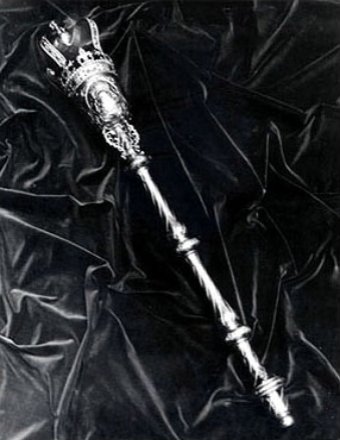
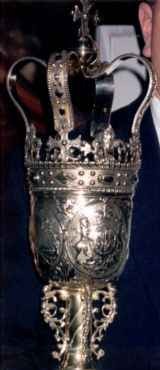 The mace currently used by the lower house of the General Assembly of South Carolina is another fine example of pre-revolutionary legislative regalia. It is a reminder of tradition in a state which takes great pride in its history and heritage. Furthermore, this ancient inheritance is still in everyday use. In 1880 the tradition of the Speaker’s procession was restored and since that year every legislative day has begun with the mace being borne by the Sergeant-at-Arms of the House, followed by the Speaker. When the Speaker reaches his chair in the House chamber, he exchanges bows with the Sergeant-at-Arms, who then places the mace upon its holster before the rostrum, exchanges bows with the Speaker once more, and thence the legislative day is called to commence. Whenever the House and Senate meet in joint session, the Mace is carried at the head of the procession.
The mace currently used by the lower house of the General Assembly of South Carolina is another fine example of pre-revolutionary legislative regalia. It is a reminder of tradition in a state which takes great pride in its history and heritage. Furthermore, this ancient inheritance is still in everyday use. In 1880 the tradition of the Speaker’s procession was restored and since that year every legislative day has begun with the mace being borne by the Sergeant-at-Arms of the House, followed by the Speaker. When the Speaker reaches his chair in the House chamber, he exchanges bows with the Sergeant-at-Arms, who then places the mace upon its holster before the rostrum, exchanges bows with the Speaker once more, and thence the legislative day is called to commence. Whenever the House and Senate meet in joint session, the Mace is carried at the head of the procession.
When the House is invited by the Senate to ratify passed legislation, the Sergeant-at-Arms bears the mace before the Speaker and the Clerk of the House in a solemn procession through the corridors of the State House, across the rotunda to the Senate chamber. There, it is put in a holding place just below the Sword of State, symbol of authority in the Senate and interesting in its own right, while the Speaker of the House, the President of the Senate, and the Clerks of both houses sign the acts. (more…)
Mary Queen of Scots’ Tree
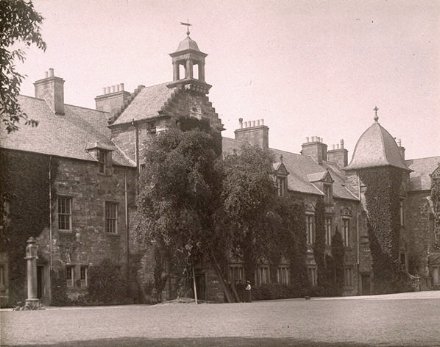
Pursuant to conversations held yesterday afternoon, I give you the thorn tree in the quad of St. Mary’s College, University of St Andrews, planted by Mary Queen of Scots. This photo was taken in the 1930’s, I believe. It looks a little worse for wear these days; rather sickly actually. Wouldn’t be surprised if the University was trying to kill it off as a safety hazard or other such bureaucratic flopdoodle.
Polo
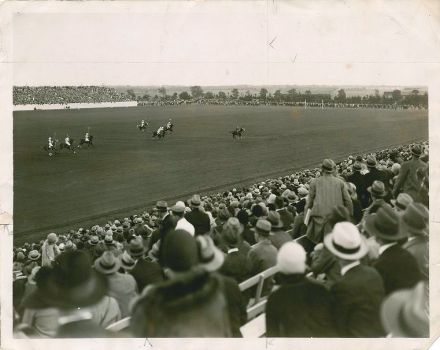
Second international polo match between the United States and the Argentine Republic, 1928.
The Colonial Colleges
| NAME |
LOCATION | FOND. | CHART. | DENOM. |
| Harvard College (Harvard University) |
Province of Massachusetts Bay |
1636 | 1650 | Puritan |
| College of William and Mary |
Colony and Dominion of Virginia |
1693 | 1693 | Anglican |
| King William’s School (St. John’s College) |
Province of Maryland |
1696 | 1784 | Non-denominational |
| Yale College (Yale University) |
Connecticut Colony |
1701 | 1701 | Congregationalist |
| Moravian College |
Province of Pennsylvania |
1742 | 1863 | Moravian |
| Newark Academy (Univ. of Delaware) |
Delaware Colony |
1743 | 1833 | Non-sectarian |
| College of New Jersey (Princeton University) |
Province of New Jersey | 1746 | 1746 | Presbyterian |
| Augusta Academy (Washington and Lee University) |
Colony and Dominion of Virginia |
1749 | 1782 | Non-sectarian |
| Public Academy of Philadelphia (Univ. of Pennsylvania) |
Province of Pennsylvania |
1749 | 1755 | Non-sectarian |
| King’s College (See below) |
Province of New York | 1754 | 1754 | Anglican |
| Rhode Island College (Brown University) |
Colony of Rhode Island and Providence Plantations |
1764 | 1764 | Baptist |
| Queen’s College (Rutgers University) |
Province of New Jersey | 1766 | 1766 | Dutch Reformed |
| Dartmouth College | Province of New Hampshire | 1769 | 1769 | Congregationalist |
| College of Charleston | Province of South Carolina | 1770 | 1785 | Non-sectarian |
| Salem College | Province of North Carolina | 1772 | 1866 | Moravian |
| Hampden-Sydney College | Colony and Dominion of Virginia | 1775 | 1783 | Presb. |
Note One: “Non-denom.” should be interpreted as Christian but not of a denominational nature. “Non-sectarian” should be interpreted as secular and having little or nothing to do with religion.
Note Two: King’s College in New York has two successor institutions: King’s College in Halifax, Nova Scotia, and Columbia University in New York, New York. The largest portion of the faculty of King’s College in New York fled north and in 1789 refounded the college in Windsor, Nova Scotia. However, the original buildings of King’s College were usurped by a new institution called Columbia College four years earlier in 1784.
King’s College formerly counted its foundation from 1754, while Columbia used the 1784 date. However, this has since switched and Columbia now proudly (though perhaps dubiously) claims 1754 as its foundation while King’s College more safely uses 1789.
Perhaps both institutions have a shared right to the founding date, as the loyal alumni continued their allegiance to King’s in Nova Scotia while the rebellious graduates considered Columbia the rightful heir. As stated, Nova Scotia had more of the people from the original foundation, whereas New York had little more than the physical building and a few of the graduates. I would be inclined to award 1754 to King’s College and 1784 to Columbia, (but then I’m biased against Columbia for being such a fallen institution).
Scruton to America
 No sooner had I read in the Independent that the eminent philosopher Roger Scruton is moving to America than Mrs. Peperium sends me this article from the local paper about the historic home the Scrutons are moving into.
No sooner had I read in the Independent that the eminent philosopher Roger Scruton is moving to America than Mrs. Peperium sends me this article from the local paper about the historic home the Scrutons are moving into.
I am sure Professor Scruton, a keen huntsman, will enjoy the Virginia hunt country. In Britain, of course, the traditional English pasttime of foxhunting is illegal and thus the police must take time from fighting and preventing terrorism to try to enforce ridiculous class-warfare laws.
Dr. Scruton, America welcomes you with open arms!
A 250-Year-Old Mace in the Old Dominion
 THE MACE OF the City of Norfolk in the Commonwealth of Virginia is believed to be the oldest civic mace in any of the United States still in use by the city for which it was made. Robert Dinwiddie, the Lieutenant Governor and Commander-in-Chief of the Dominion of Virginia, commissioned the English silversmith Fuller White to make the silver and wood mace for the City of Norfolk, at the time the largest town in the crown colony. The inscription around the base of the bowl of the Mace denotes the generous donation:
THE MACE OF the City of Norfolk in the Commonwealth of Virginia is believed to be the oldest civic mace in any of the United States still in use by the city for which it was made. Robert Dinwiddie, the Lieutenant Governor and Commander-in-Chief of the Dominion of Virginia, commissioned the English silversmith Fuller White to make the silver and wood mace for the City of Norfolk, at the time the largest town in the crown colony. The inscription around the base of the bowl of the Mace denotes the generous donation:
Despite the inscription of 1753, the mace took some time to reach the shores of America, and the minutes of the Norfolk council record the actual presentation:
Fuller White built the mace of eleven interlocking pieces of sterling silver weighing 104 ounces, which centered around a wooden rod. The Norfolk mace measures forty-one-and-a-half inches long from the very bottom of the base to the apex of the crown.
The Royal Arms, depicted in three places on the mace, most prominently outside the bowl and inside the base of the crown, are those of George II, Britain’s second German king known for his poor grasp of the English language.
In several places on the mace are depicted national emblems of George’s realm: the English rose, the Scottish thistle, the Irish harp, and the fleur-de-lis representing the claim to the throne of France still maintained — at least heraldically — at the time. (more…)
Films Recently Viewed
| The Life and Death of Colonel Blimp 1943 Directed by Michael Powell and Emeric Pressburger. A fine film, worth seeing. I’ve spied a few Blimps-in-training at the Mess in Wyvern. Also, Theo Kretschmar-Schuldorff is a heck of a good name for a character. |
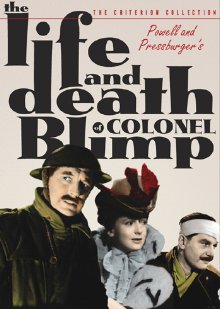 |
| La Grande Illusion 1937 Directed by Jean Renoir. I enjoyed this film greatly. It made me wish I had been a WWI pilot shot down by the Huns just so I could be invited to luncheon with the German officers. Everyone comported themselves well in those days (or at least in the cinema version of those days). According to IMDB, the Viennese Erich von Stroheim had spent so much time in America that he could barely speak German when the film was made. |
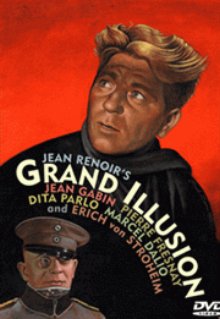
|
| The Birth of a Nation 1915 Directed by D.W. Griffith. Disturbing. The film’s basic premise that the United States was forged as a nation by the white knights of the Ku Klux Klan is balderdash, pure and simple. Still, a powerful and remarkable propaganda film. “It is like writing history with lightning, and my only regret is that it is all so terribly true,” said Woodrow Wilson, whose Southern racism most modern liberals like to ignore. |
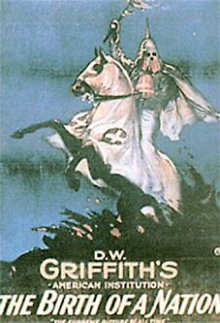
|
| Alexander Nevsky 1938 Directed by Sergei M. Eisenstein, score by Sergei Prokofiev. More brilliant propaganda, this time for the USSR, not the KKK. Beautifully shot, but the battle scene is a tad too long. Though very nationalistic, it is not hard to see the communism behind the film in a number of scenes. Found the only slightly veiled swastikas on the mitre of the Teutonic bishop rather droll. |
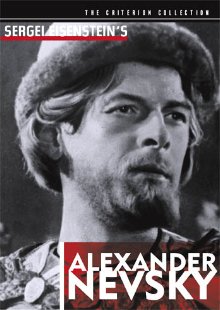
|
| The Battle of Algiers 1965 Directed by Gillo Pontecorvo, score by Ennio Morricone. My second viewing of this splendid film. Colonel Mathieu: “There are 80,000 Arabs in the Casbah. Are they all against us? We know they’re not. In reality, it’s only a small minority that dominates with terror and violence. That minority is our adversary; we must isolate it and destroy it.” And they did. Still managed to lose Algeria though – which was a damn shame for the Algerians. |
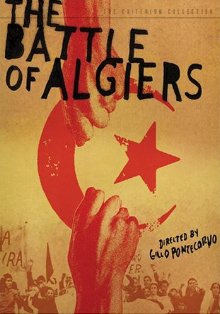
|
Chesterton Remembered
SIR: Your article on G.K. (This England, Summer 1986) brought back a happy personal memory of that great and kindly man. It was 1930 in Rome, where I was a pupil at a “finishing school” – in this case an English convent. G.K. sometimes came to visit our Reverend Mother; we knew him by sight and, once seen, who could forget the huge man in the big black cloak?
Part of our “finishing” process was to be taken round the museums and galleries of the Eternal City. One day we were being shepherded through the Vatican Museum. My friend and I somehow managed to get separated from the rest of our party and in one of the galleries whom should we see but Mr. G.K. Chesterton. He was about to leave so we followed him down the stairs in the hope of being able to get his autograph. At the foot of the stairs he turned. “As we had such young legs”, he said, “could one of us be so kind as to run back to the gallery where he had left his cloak, and would the other see if she could find him a carrozza [a cab, lit. ‘carriage’]?” We needed no second bidding. I raced back up the stairs, found the familiar black cloak where he had left it and triumphantly returned it to its owner. Meanwhile my friend had found a vacant carrozza. G.K. thanked us both, climbed into the carrozza and drove off. In the excitement we had forgotten about the autographs! Next day a letter arrived at our convent. He addressed it to “The Young Ladies suffering education at the convent at No. 10 Via Boncompagni.” Inside was a sheet full of auto-graphs and a little poem.
For you alone did I desire,
Who brought the prophet’s mantle down
And called his chariot of fire!
I have the precious autograph still and what a strange Chinese-looking affair it is!
— MRS. L. RIPLEY, BRIGHTON
Chartres 2005
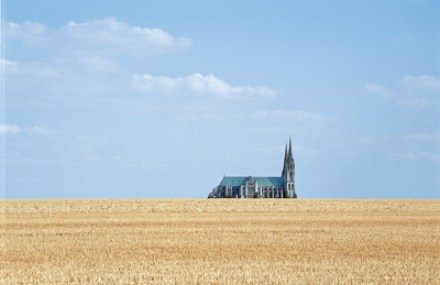
Various sites have put up photos from this year’s annual traditionalist Pentecost pilgrimage to Chartres, and I thought, as I did last year, I would gather a few of them and present them to you. (more…)
The ‘New South’ Scorns an Old Mace
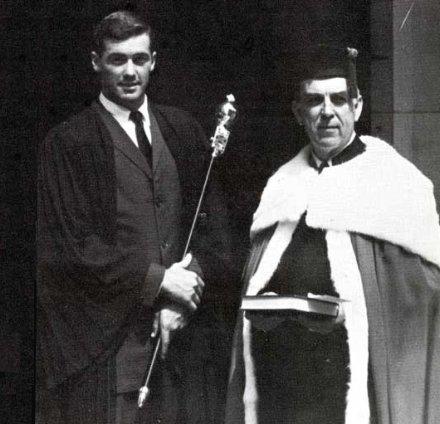
George Hart, President of the Order of Gownsmen, bears the University Mace for the Vice-Chancellor, Dr. McCrady
“The recent convocation at Sewanee’s All Saints’ Chapel was a majestic display,” writes the Atlanta Journal-Constitution. “University hierarchs in medieval garb spoke Latin, their words echoing throughout the nave. New honor students donned black robes, marking their entrance into the prestigious Order of Gownsmen. Everyone sang: “Alma Mater, Sewanee, My glorious Mother ever be. (more…)
His Holiness and His Most Eminent Highness
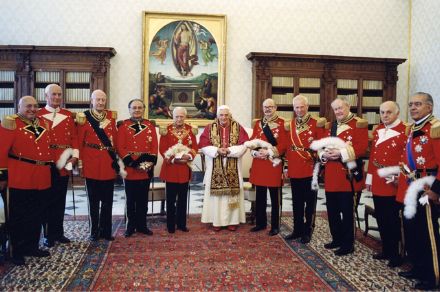
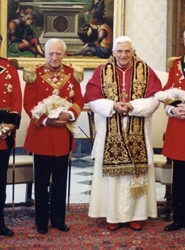 By special request, I bring you photos of the recent audience of His Holiness Benedict XVI, Bishop of Rome, Vicar of Jesus Christ, Successor of the Prince of the Apostles, Supreme Pontiff of the Universal Church, Patriarch of the West, Primate of Italy, Archbishop and Metropolitan of the Roman Province, Sovereign of the State of the Vatican City, Servant of the Servants of God (to use his full title) with His Most Eminent Highness, Fra’ Andrew Willoughby Ninian Bertie, Prince and Grand Master of the Sovereign Military and Hospitaller Order of St. John of Jerusalem, of Rhodes, and of Malta, Most Humble Guardian of the Poor of Jesus Christ (likewise, to use his full title) along with the Sovereign Council of the said order. According to ecclesiastical protocol the Grand Master, though merely a vowed religious, is accorded a dignity equal to that of a cardinal. His Holiness received the Grand Master and Sovereign Council on June 24, 2005, the Feast of St. John the Baptist, who is the patron saint of the Order. The Grand Master was also greeted on April 24 of this year, when the photograph below was taken.
By special request, I bring you photos of the recent audience of His Holiness Benedict XVI, Bishop of Rome, Vicar of Jesus Christ, Successor of the Prince of the Apostles, Supreme Pontiff of the Universal Church, Patriarch of the West, Primate of Italy, Archbishop and Metropolitan of the Roman Province, Sovereign of the State of the Vatican City, Servant of the Servants of God (to use his full title) with His Most Eminent Highness, Fra’ Andrew Willoughby Ninian Bertie, Prince and Grand Master of the Sovereign Military and Hospitaller Order of St. John of Jerusalem, of Rhodes, and of Malta, Most Humble Guardian of the Poor of Jesus Christ (likewise, to use his full title) along with the Sovereign Council of the said order. According to ecclesiastical protocol the Grand Master, though merely a vowed religious, is accorded a dignity equal to that of a cardinal. His Holiness received the Grand Master and Sovereign Council on June 24, 2005, the Feast of St. John the Baptist, who is the patron saint of the Order. The Grand Master was also greeted on April 24 of this year, when the photograph below was taken.
If we have any more Order-of-Malta-related posts, a whole category will have to be devoted to them!
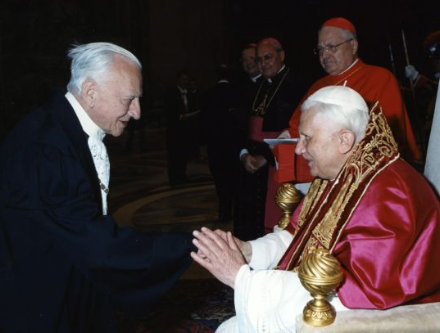
Happy Dominion Day!
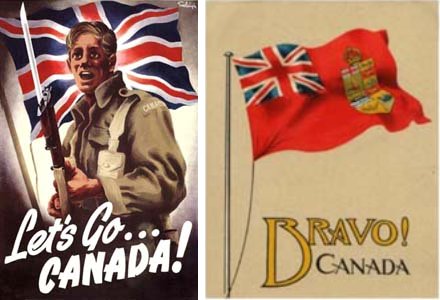
A day late, I hope all our Canadian friends and neighbours have enjoyed a happy and blessed Dominion Day. In tribute to the Great White North, I present our dear readers with that wonderful song, the anthem of anglophone Canada – thistle, shamrock, rose entwined – the Maple Leaf Forever. It is one of my favorite tunes, and were I governor of this fair land, after making coattails and top hats de rigeur for gubernatorial events, I think I’d steal the notes and make a new song called Empire State Forever.
So all that remains is to say long live Canada and God Save the Queen!
[Click here for MP3 audio file]
In Days of yore, from Britain’s shore,
Wolfe, the dauntless hero came,
And planted firm Britannia’s flag,
On Canada’s fair domain.
Here may it wave, our boast, our pride,
And joined in love together,
The thistle, shamrock, rose entwined,
The Maple Leaf forever!
The Maple Leaf, our emblem dear,
The Maple Leaf forever!
God save our Queen, and Heaven bless,
The Maple Leaf forever!
At Queenston Heights and Lundy’s Lane,
Our brave fathers, side by side,
For freedom, homes, and loved ones dear,
Firmly stood and nobly died;
And those dear rights which they maintained,
We swear to yield them never!
Our watchword evermore shall be,
The Maple Leaf forever!
The Maple Leaf, our emblem dear,
The Maple Leaf forever!
God save our Queen, and Heaven bless,
The Maple Leaf forever!
Our fair Dominion now extends
From Cape Race to Nootka Sound;
May peace forever be our lot,
And plenteous store abound:
And may those ties of love be ours
Which discord cannot sever,
And flourish green o’er freedom’s home
The Maple Leaf forever!
The Maple Leaf, our emblem dear,
The Maple Leaf forever!
God save our Queen, and Heaven bless,
The Maple Leaf forever!
On merry England’s far-famed land,
May kind Heaven sweetly smile;
God bless Old Scotland evermore,
And Ireland’s Emer’ld Isle!
Then swell the song, both loud and long,
Till rocks and forest quiver,
God save our Queen, and Heaven bless
The Maple Leaf forever!
The Maple Leaf, our emblem dear,
The Maple Leaf forever!
God save our Queen, and Heaven bless,
The Maple Leaf forever!
Perhaps the Most Vile Sentence Ever Printed in Any Governmental Document in the Entire British Commonwealth of Nations
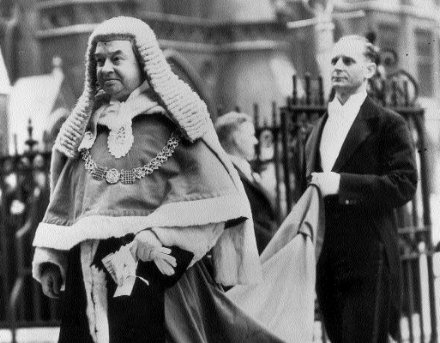
‘Court Working Dress in England and Wales’, May 2003
This sentence alone epitomises the noxious worldview of the modernist. It is a sentence that pronounces with totalitarian authority a ruling to which it allows no appeal. Tradition, they would tell us, has no inherent value in and of itself. It is nothing but a potential boon to the tourist industry – which is thoroughly reprehensible itself.
Yes, you heinous ignoramuses! There is a justification for retaining wigs and gowns in court on the grounds of tradition alone: thus it is, and ever thus it has been, and ne’er has a soul come to harm because of it! Fat, vile, impudent, ignorant modernist bureaucrats! I believe there is a tradition in the American South involving a self-appointed gang of citizens, a noose, and a tree with strong branches. I couldn’t think of a more appropriate exercise of such a tradition than ridding us of the damnable soul – loathsome, worthless degenerate! – who composed that sentence with all its odious implications.
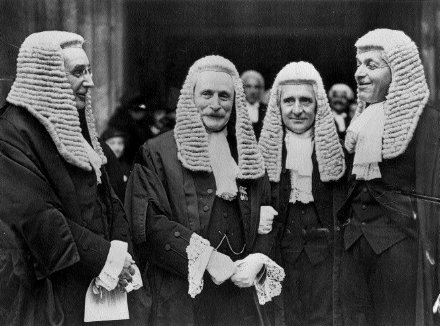
You may read the detestable ‘consultation paper’ online at what was the Lord Chancellor’s Department but which has since been corporately rebranded by Tony and the gang as the ‘Department for Constitutional Affairs’ with its own catchphrase ‘Justice, rights and democracy’ (sic), lacking the Oxford comma. There are further contemptible utterances in the document; it is not for the faint of heart.
Rip van Winkle
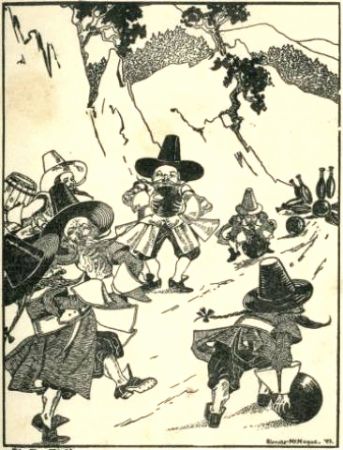
When was the last time you read the story of Rip van Winkle? If you’ve never had that pleasure, then you are all the worse for it, my friend. The tale was handed down to us through the ages by the munificence of one Diedrich Knickerbocker, though some sore-minded rapscallion later credited the ever-capable Washington Irving with its invention. Anyhow, it is one of my favorite tales in all the history of New York. It’s a short story, and worth a read online if you haven’t a printed copy immediately at hand.

The tale, of course, revolves around “a simple good-natured fellow”, namely Rip van Winkle, and his encounter with “odd-looking personages” whom still to this day show themselves around the Hudson valley. We merely have ceased to hear reports of them because thoroughly unimaginative types are in control of the world these days. (The “monotony monitors” as my Latin teacher monikered them, enforcing boredom and mediocrity at every possible opportunity).
The genealogists amongst you will be interested that Mr. Knickerbocker notes this van Winkle was “a descendant of the Van Winkles who figured so gallantly in the chivalrous days of Peter Stuyvesant, and accompanied him to the siege of Fort Christina.” Now, for want of fast-paced action, you may not have any particular desire to read about a simple, good-natured fellow like Rip van Winkle, but desires aside you must read “the Most Horrible Battle Ever Recorded in Poetry or Prose” (Chapter VII of Book VI of the same Diedrich Knickerbocker’s A history of New York, from the beginning of the world to the end of the Dutch Dynasty). The record of the siege of Swedish Fort Christina by the good New Netherlandish is the most hilarious and enchanting chronicle of any battle anywhere.
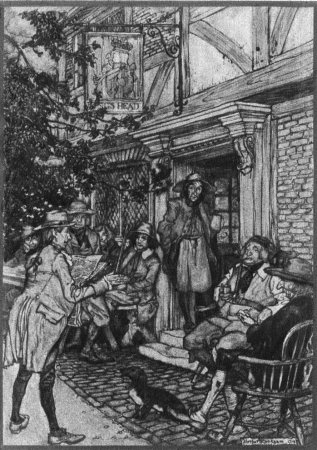
The Officers’ Mess
Last night was spent in the Mess at Wyvern (HQ, A Sqd, TUOTC), which is one of the most delightful places in St Andrews. They have the cheapest pint in town, and even still it somehow seems you only need to drink half as much as usual to alter your consciousness.
If you are not a member of the Officer Training Corps, and I am not, then you have to be signed in by a member (2LT. Chris C. obliged) and introduced to the PMC, Tom Kerr, who lives a few floors above me and is an admirable man despite having gone to school with Dave Watt. Wyvern’s a beautiful house though, and adequately looked after by A Squadron of the Tayforth Universities Officer Training Corps.
Speaking of Mr. Watt, Dave had gone to Wine and Cheese that evening and showed up in the Mess pretty late, grievously attired in a black shirt with red stripes, accompanying tie, a white jumper, and with the obligatory blazer on top. He had hassled along some other OCDT (officer cadet) who had been at Wine and Cheese that evening to come along to the Mess. Now this chap was decked up in the more usual tweed jacket (and riding boots, without explanation) but was lacking in necktie. As one might expect, jacket and tie are de rigeur for the Mess, and once the said tie-less fellow showed up the lack of tie was noted and brought to the attention of the PMC.
Disgrace! What was to be done? A Mess Court would be convened, Tom Kerr presiding. The shameless and inebriated David Watt would provide the defense, the shameless and inebriated Chris C. the prosecution, and George Irwin, Euan Gorford, and I were appointed as jury.
Now, the poor lad in the dock, whom we shall call Oliver George Wilson, since, when asked to state his name for the court, he replied “Oll… Oll… Oliver George Wilson”. Well, the poor Oliver George Wilson could barely compose a coherent sentence, most likely due to the imbibing of wine at “Chine and Weese”, and seemed to posess very few of his own faculties and certainly even fewer of anyone else’s. Nonetheless the Prosecution opened the case charging Oliver George Wilson with entering the mess without a tie by effortlessly pointing to Oliver George Wilson sitting in the makeshift dock (actually a barstool) suffering from a complete lack of any form of neck attire bar
the collar of his shirt.
I began to have my suspicions as to the integrity of the court when I, a member of the jury, was called to testify on behalf of the prosecution. Now, the questions interrogated of me and the responses freely, and I dare say deftly, given are not for stating in the public realm. Nonetheless they were of a such a nature as to make the padre blush (or so Gorford told me when I left the stand and returned to the jury), and the denizens of the Mess were rollicking, so in my humble opinion it’s all for the better.
The defense was then given the opportunity to state their case, which was lacking. [Note to self: if in trouble, never call on Dave Watt to act as my defense]. Mr. Watt threw out some rambling, barely grammatical sentences in a highly dramatic style which he no doubt hoped would distract the jury from the matter at hand. It was to no effect, as the jury of three — and a fine jury it was, mind you, one of the best juries in the land — as I was saying, the jury of George, Euan, and I were pretty much convinced by the defense’s argument and my own stand in the witness box and thus Oll… Oll… Oliver George Wilson was convicted on all charges. Lord Chief Justice Kerr sentenced the delinquent to an “H.M.S. Wyvern” which involves drinking lots of gin and being turned around incessentantly, this processes being repeated four times in some vaguely nautical fashion while singing, not their own A Squadron ditty, but instead the B Squadron (Dundee University) song, to the tune ‘Cwm Rhondda’ aka Guide Me O Thou Great Redeemer:
We dont worry about pregnancy,
We just lack imagination,
Dundee O.T.C. are we,
Ugly women,
Joke degrees,
We will probably beat our wives!
We will probably beat our wives!”
Dundee, frightful. Oliver George Wilson didn’t even chunder (at least not in the faux German helmet in the Mess designated for such a purpose), and thus a good time was had by all.
Grandpa
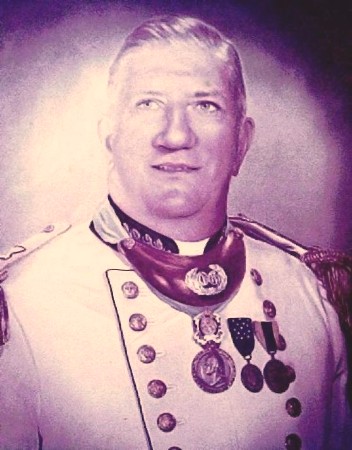
Commandant, Old Guard of the City of New York.
Grant’s Tomb
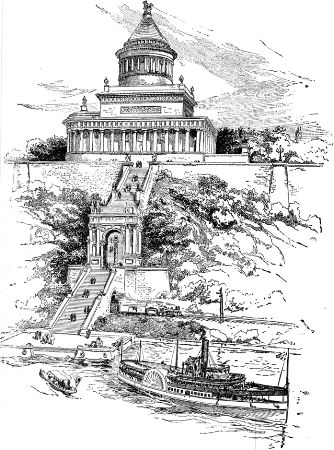
I came across this illustration of the original plan for Grant’s Tomb in Riverside Park on the Upper West Side, back home in New York. The differences are conceptually slight, except for the complete lack of this grand staircase and triumphal arched watergate on the Hudson River, which was never constructed. It would be an intriguing addition if built, but I think slightly awkward, as it leads up to the side of the mausoleum, rather than the front. Had the tomb been constructed with its orienation towards the Hudson rather than on the axis of the long Riverside Park, it might be sucessful, but otherwise, it was wise of the city fathers not to execute this part of the plan.
For more views of Grant’s Tomb, see the Bridge and Tunnel Club’s page.
‘The Pope: A Portrait from Life’
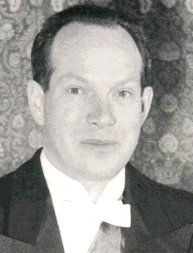 LAST NIGHT I finished reading ‘The Pope: A Portrait from Life’ by Constantine, Prince of Bavaria, about Pope Pius XII (who I thought had already been beatified, but not yet). It is definitely one of the biographies I have most enjoyed, perhaps even most enjoyed. The book’s strength lies not in academic depth nor in attention to detail but in giving the reader a great insight into the great man who Pius XII was. From his brilliant diplomacy, working for peace during the First World War under Pope Benedict XV, warning of the dangers of National Socialism as nuncio to Germany under Pope Pius XI, his own accession in 1939, and his tireless efforts to give shelter to all who were in need: Socialists, Communists, Jews, Christians, Atheists, Liberals, Royalists, Republicans, escaped Allied prisoners of war, and after the war, fascists, collaborators, Germans, and others whose lives (and souls) were equally in danger. There was no barrier of race or religion or party or ideology. Indeed, the Grand Rabbi of Rome, sheltered by Pius XII during the war was so inspired by him that three years after the war ended, he became a Christian, taking the name ‘Eugenio’, Pius’s birth name.
LAST NIGHT I finished reading ‘The Pope: A Portrait from Life’ by Constantine, Prince of Bavaria, about Pope Pius XII (who I thought had already been beatified, but not yet). It is definitely one of the biographies I have most enjoyed, perhaps even most enjoyed. The book’s strength lies not in academic depth nor in attention to detail but in giving the reader a great insight into the great man who Pius XII was. From his brilliant diplomacy, working for peace during the First World War under Pope Benedict XV, warning of the dangers of National Socialism as nuncio to Germany under Pope Pius XI, his own accession in 1939, and his tireless efforts to give shelter to all who were in need: Socialists, Communists, Jews, Christians, Atheists, Liberals, Royalists, Republicans, escaped Allied prisoners of war, and after the war, fascists, collaborators, Germans, and others whose lives (and souls) were equally in danger. There was no barrier of race or religion or party or ideology. Indeed, the Grand Rabbi of Rome, sheltered by Pius XII during the war was so inspired by him that three years after the war ended, he became a Christian, taking the name ‘Eugenio’, Pius’s birth name.
‘The Pope: A Portrait from Life’ tells the story of Eugenio Pacelli with anecdotes and stories from all the people surrounding this, the most lied-about figure in the history of the twentieth century. I strongly recommend this book to anyone interested in the life of Bl. Pius XII. It is almost cinematic as it moves from scene to scene, from the present (Rome 1954) to the past, in Rome, in Germany, in America over the years of Eugenio Pacelli’s career as priest, churchman, diplomat, and finally pontiff.
Constantine himself (pictured above) is interesting in his own right. Born in 1920, with all the Royal House of Wittelsbach he was kicked out of the German Army by Hitler and, in 1944, arrested by the Gestapo. Liberated by the French, he went on to work for the International Red Cross, until 1947 when he went to work in the Munich office of the Associated Press. In 1950, he became editor of Germany’s Revue magazine, and was later elected to the Bundestag. Unfortunately, he died in an air crash in 1969. This book as evidence of Contantine’s adroitness in the journalistic profession. It is no longer in print, sadly, and so hard to find, but if you do ever happen to come across it, buy it, read it; you will not be disappointed.
The Kate Kennedy Procession 2005
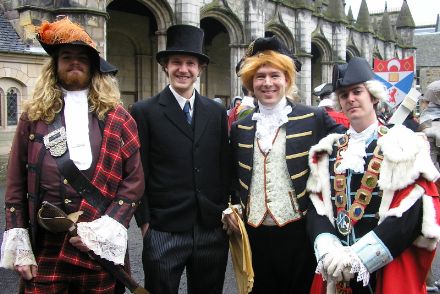
Once again it is Procession Day here in St Andrews, when we have the annual Kate Kennedy Procession to harken the return of springtime. Unfortunately, like last year, it was on the cold side and rather grey, despite some truly beautiful days previously.
For those of you who don’t know it, the Kate Kennedy procession is a medieval rite of spring which was resurrected in the past century. Kate Kennedy, according to lore, was the niece of Bishop James Kennedy, the founder of St. Salvator’s College. Owing to her beauty, a procession was held in spring in her honor, according to lore. Eventually, these became pretty rowdy, and as such were banned in the 19th century. In the 1920’s, Donald Kennedy, an indirect descendant of Bishop Kennedy himself, decided the resurrect the procession and founded the Kate Kennedy Club for this distinct purpose.
The Club admits nine new members each year from the bejant (first year) class. One of these is selected to portray the comely Kate Kennedy in the Procession, and is joined by the eight other bejants as sheild-bearers, and other students, members, and friends of the University who dress up as important figures from the history of town and gown. (more…)
Greenwich Hospital
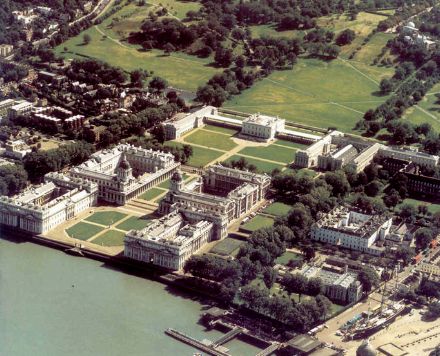
One of my favorite campuses (campii?) in the world is the Royal Hospital at Greenwhich. The site was originally home to the Palace of Placentia, a royal palace built by Humphrey, Duke of Gloucester in 1428. Placentia was the primary royal residence for two centuries up unto the Civil War, after which it fell into ruin. In 1694, the Royal Naval Hospital for Seamen was established as a home for old sailors, and grandiose architecture was required to show the monarchic splendor of a royal foundation. (more…)
Search
Instagram: @andcusack
Click here for my Instagram photos.Most Recent Posts
- Amsterdam November 26, 2024
- Silver Jubilee November 21, 2024
- Articles of Note: 11 November 2024 November 11, 2024
- Why do you read? November 5, 2024
- India November 4, 2024
Most Recent Comments
- on The Catholic Apostolic Church, Edinburgh
- on Articles of Note: 11 November 2024
- on Articles of Note: 11 November 2024
- on Why do you read?
- on Why do you read?
- on University Nicknames in South Africa
- on The Situation at St Andrews
- on An Aldermanian Skyscraper
- on Equality
- on Rough Notes of Kinderhook
Book Wishlist
Monthly Archives
Categories


